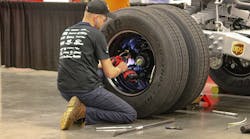Much has changed in the last few years in the trucking industry. Fuel prices and inflation are out of control one month and seem to stabilize the next. Labor and parts scarcity appear to spell certain doom for awhile, and then fleets find a way to adjust. Government emissions and electrification plans will certainly transform trucking over the next decade, but the question remains if that will be for the better or worse.
What’s all this mean? Well, to me, it means that the future is often volatile and uncertain. And to succeed in this competitive and critical industry that impacts billions of people, you need to prepare for anything and everything.
To hedge against rising fuel costs, perhaps investigate which low-rolling resistant tires offer the best total cost of ownership for your routes and if a tire pressure monitoring system will help even further.
On the parts and labor front, evaluate how often issues, such as with aftertreatment systems, are being misdiagnosed and how many hours and repair items are being wasted because of them. Would a significant investment in better diagnostic tools and technician training today prevent years of hassles down the road?
I won’t pretend to have any answers for the electrification stuff, other than to keep apprised of what is going on in your state in terms of incentives, subsidies, and energy infrastructure, and talk to as many early adopters as possible on the pros and cons of various technologies. Try not to fall victim to either hype or pessimism.
Most importantly, allow at least a little room for optimism. This is an industry full of hard-working, intelligent, and motivated people. That’s what I saw at the most recent American Trucking Associations Technology & Maintenance Council’s Fall Meeting, where there was a lot to get excited about.
For one, TMCSuperTech was back in full force after a scaled-down event last year (with fewer than 40 participants), and no event in 2020. About 140 current and prospective technicians descended on Cleveland’s Huntington Convention Center this year for TMC SuperTech and TMCFutureTech, and the two-day competition required the full breadth of the convention center’s 225,000 sq.-ft. exhibit floor space.
FedEx Freight’s Bonnie Greenwood, one of a handful of female technicians at the event, came in second place overall, which should help persuade other women that the commercial vehicle repair sector is a place they can flourish—if they like the job and put in the work. Greenwood was also the first woman to win TMCFutureTech, and this was her first attempt at the professional-level skills challenge, so it’s conceivable she could become Grand Champion at some point. That would be a boon for female tech recruitment, which the industry sorely lacks in.
Now, I must remind you that leaving a little room for optimism means saving the rest for pragmatism. Managing the maintenance and repair of a fleets’ commercial vehicles is still one of the more challenging jobs out there in a post-pandemic world. At the Fall Meeting Fleet Talk, only one hand out of hundreds raised when asked if they had no trouble finding labor.
Fleets and shops are also having a tough time finding equipment. According to an independent representative for an alignment manufacturer I spoke with at the HD Repair Forum (co-located with the TMC Fall Meeting), equipment made with steel can take up to six months to deliver.
According to Mohawk Lifts President Steve Perlstein, competitors’ customers are coming to the manufacturer because they have been waiting several months for lifts. He said, in August, a distributor from California told him he had been waiting on another company to deliver a lift since April. That distributor had a deposit and an increasingly frustrated customer, but still no lift.
Perlstein said he could likely deliver by mid-September. He was confident in that estimate because Mohawk sources U.S.-made steel and also solved a similar issue in June. That previous customer, based in Idaho, needed a 25,000-lb. four-post drive-on lift and had been waiting six months on another lift manufacturer. Perlstein quoted him six weeks and delivered in just over five.
Mohawk is not immune to those aforementioned labor challenges, though.
“Everybody wants to say that things are groovy, but my supply chain crisis is more staffing shortages, like everybody in the world is having,” Perlstein relayed. He said everything from retirement to people unwilling to work has caused this crisis.
“That’s why we have attendance bonuses, retention bonuses, signing bonuses—those kinds of things that we’re doing these days,” he said. “But [the supply issue is] still people more than anything. And this represents the biggest problem in the industry.”
When spec’ing new shop equipment, Perlstein advised to go with what lasts and provides the best total cost of ownership, even if it costs more upfront.
“Yes, I’m going to charge somebody more on the day that they buy it, but I’m also going to provide them the cheapest lift they’re ever going to own,” he asserted. “And there is always a cost of ownership on everything you buy. I don’t care what it is.”
He noted Mohawk lifts have a 25-year factory warranty and their leaf chains have a 10-year warranty. Lifting cable, by contrast, may be backed by a one-year warranty.
“A new set of cables is $200-$300 depending upon which lift you have. And it’s a couple hundred dollars in downtime, and a couple hundred more in the service work performed by the local repair technician,” he explained. “And guess what happens a year or two after that? That happens all over again.”
The cost of steel, meanwhile, is rising. “Pre-COVID, steel used to be only about $0.60/lb., and it’s about $1.00/lb. now,” Perlstein said. “Everything has gone up, up, up like there’s no tomorrow.”
There, of course, will still be a tomorrow, and countless days after that. And if you want to stay in business, you have to plan for all of them.




